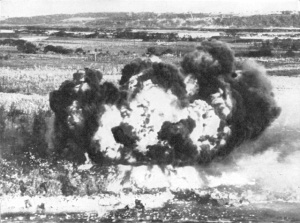![]() The Pacific War Online Encyclopedia
The Pacific War Online Encyclopedia
|
| Previous: Napa Junction | Table of Contents | Next: Napier Class, Australian Destroyers |

U.S. Marine Corps. Via ibiblio.org
Napalm is a thickening agent made from aluminum salts of napthenic and palmitic acids. Napthenic acid is a byproduct of oil refining while palmitic acid is a tropical vegetable oil present in copra. When mixed with gasoline (petrol), napalm forms a viscous, sticky mixture (dubbed "hell-jelly" by U.S. Army aircrew at Tinian) that burns more slowly than plain gasoline. These properties improve the effectiveness of the gasoline as an incendiary in warfare.
Napalm found use in flamethrowers, whose range and
accuracy it increased markedly. The burning fuel stuck to whatever it
hit rather than flowing to ground level where it was less effective.
Napalm was also used in incendiary bombs
for both tactical and strategic
bombing. Napalm bombs were first used by Army pilots at Tinian in July 1944 and by naval aviators during the strikes preceding the Leyte
operation in September
1944.
The napalm bomb used to burn down the cities of Japan was the M-69, which weighed 6.2 pounds (2.8 kg) and was dropped in clusters of sixty that were designed to burst apart at a designated altitude. Each M-69 trailed a three foot (1 meter) cloth strip that slowed the bomb and stabilized its descent. A few seconds after the bomb hit a solid surface, a small charge went off, spreading the napalm as much as 100 feet (30 meters) and igniting it.
Napalm for flamethrowers came in a gallon container
that was stirred into 55-gallon drums of gasoline as required. This was
a slow, unpleasant process, and Marine
tank crew on Iwo Jima improvised a
bubble generator connected to an air compressor that allowed a barrel
of napalm to be mixed in a few minutes.
References
Gilbert (2001)
The Pacific War Online Encyclopedia © 2008-2009, 2011 by Kent G. Budge. Index